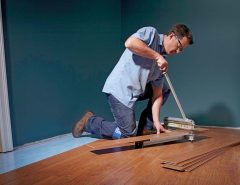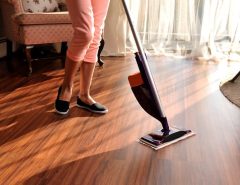Vinyl plank flooring has become an increasingly popular flooring option for homes and businesses in recent years. Made from PVC and shaped to mimic wood or stone, vinyl plank flooring is durable, affordable, and easy to install. But what if you want to replace your vinyl planks or reuse them in a different room? Is it possible to remove and reinstall vinyl plank flooring? The short answer is yes, with proper care and technique, you can remove and reinstall vinyl plank flooring successfully.
How Vinyl Plank Flooring Works
Before getting into the details of removing and reinstalling vinyl planks, it helps to understand how they are constructed.
Vinyl plank flooring is made up of three layers:
- Wear Layer: This top layer is a transparent vinyl film that protects the floor from wear and tear. It has a printed design to mimic wood, stone, or other materials.
- Printed Vinyl Layer: Underneath is a solid vinyl core layer that contains the patterns and colors that show through the wear layer.
- Backing Layer: On the bottom is a backing layer made of vinyl or PVC that provides stability and structure.
The planks click together through a tongue-and-groove system along the sides and sometimes also the ends. An attached underlayment provides cushioning and sound dampening. Most vinyl planks use a “floating” installation method and are not secured to the subfloor.
Can You Remove the Vinyl Plank Flooring?

With their locking mechanisms and layered construction, vinyl planks are designed to be taken up and reinstalled if needed.
However, there are some important factors to consider:
Installation Method
- Floating floors are the easiest to remove. You simply have to disconnect the tongue-and-groove planks from each other.
- Glue-down vinyl requires breaking the adhesive bond, which can be difficult and damage the planks.
- Nailed or stapled planks involve pulling up floorboards and removing fasteners.
In general, opt for floating vinyl planks if you think you may want to remove them someday.
Plank Condition
Gently removing vinyl planks without harming them takes patience and care. Planks that are older or cheaper quality are more prone to breakage during removal. Inspect your vinyl planks closely first to check for any cracks or weak points.
Subfloor Surface
Removing vinyl that was installed over concrete is much more difficult than taking up planks over wood. The smooth, hard surface of concrete allows the planks to bond more tightly. You may have to chisel or grind areas to dislodge stubborn vinyl from concrete subfloors.
With extra preparation and by working slowly, it is possible in most cases to remove vinyl plank flooring without too much damage, as long as it is a floating installation.
Steps for Removing Vinyl Plank Flooring
Here is a step-by-step guide to safely remove vinyl plank flooring:
- Clear the area by moving out any furniture or belongings. This gives you open space to work.
- Inspect planks for damage and weak or brittle areas. Also, check for mold or mildew.
- Find the plank edge and gently pry up the first row. Use a putty knife or pry bar, working slowly to protect the vinyl. Insert the tool into the seam and twist slightly to disconnect.
- Work outward from the first row into the room, disconnecting planks row-by-row. Be patient and ease planks up, rocking slightly as needed. Stack planks face down as you remove them.
- Cut the final row to detach from the wall. You can usually reuse cut planks for the first row in the new installation.
- Check the subfloor and clean thoroughly after all planks are removed. Repair any damaged areas before reinstalling.
- Inspect & clean planks on both sides. Sort by length and set aside any that are cracked or warped. These may need a replacement for new installation.
With time and care, vinyl planks can be removed intact and prepared for reuse. Any damaged planks will need to be exchanged before reinstalling the floor.
Can You Reinstall the Vinyl Plank Flooring?

Once removed, the vinyl plank was reinstalled in a new area provided the planks were still in good condition.
Here are some tips for reusing vinyl planks successfully:
- Firm subfloor – Make sure the new installation area has a proper subfloor that is flat, even, and structurally sound.
- Level planks – Check that planks are flat and straight. Warped or twisted planks will leave gaps and should be replaced.
- Stagger layout – Don’t repeat the same installation pattern. Stagger planks randomly to disguise seams.
- Fresh underlayment – Use new foam underlayment throughout for maximum cushioning and noise reduction.
- Fill expansion gaps – Leave small expansion gaps around the perimeter and between rooms. These help prevent buckling.
- New transition moldings – Install new coordinating trim pieces around doorways and edge of flooring.
- Clean thoroughly – Wipe down all planks with vinyl floor cleaner before installing them in the new space.
- Work slowly – Take your time connecting planks to avoid damage.
With some handy preparation, those quality vinyl planks removed from another room can often be reused to create a “new” floor in a different area of your home.
Conclusion
Vinyl plank flooring is a versatile and durable flooring option, making it a popular choice for homeowners. With some care and effort, vinyl planks can be successfully removed and reinstalled in a new area if needed. Check planks carefully for damage, clean the subfloor and planks thoroughly, and take time laying the floor to get the best results reusing your vinyl planks. With smart preparation and installation, you can give your vinyl plank flooring a fresh new life in a different room.
FAQs
Can you remove vinyl planks without damaging them?
Vinyl planks can usually be removed without damage if done carefully and if they were installed as floating floors. Go slowly, use proper tools, and inspect planks thoroughly beforehand.
Do vinyl planks need to acclimate before reinstalling?
Yes, allow vinyl planks to acclimate to the temperature and humidity of the new space for 24-48 hours before installation. This helps prevent expansion issues.
How long do vinyl planks last when reinstalled?
With proper prep, quality vinyl planks can have a similar lifetime when reinstalled as they would for the original installation, around 15-30 years. Durability depends on wear layer thickness and usage.
Can you mix old and new vinyl planks?
It’s best to use all old planks or all new planks. Mixing worn and new planks can highlight differences in gloss, color, and thickness. Blend any new replacement planks discretely.
Should underlayment be replaced when reinstalling vinyl?
Yes, using new foam underlayment provides maximum sound dampening and a smooth, consistent surface for the planks. Only reuse underlayment if it’s completely clean and undamaged.
Tags: best vinyl plank flooring, home depot vinyl plank flooring, how to clean vinyl plank flooring, how to install vinyl plank flooring, installing vinyl plank flooring, lowes vinyl plank flooring, luxury vinyl plank flooring, waterproof vinyl plank flooring



